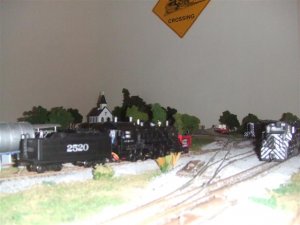Well, drove up north about an hour to the nearest LHS that has a decent selection of trains and picked up my special ordered Bachmann Spectrum 2-8-0. This thing is awesome! This is the best Spectrum Iv'e seen so far, Union Pacific, blackened hand rails, valve gear, etc., with the dark wheels with highlighted rims. Haven't run it yet, due to had to paint the engine / tender wiring flat black and letting it dry. Not many prototypes had red and pink wiring, as I remember.
I see now why the 2-8-0's are some of Dr. Waynes favorites. This just might replace my Decopod as no. 1 engine on my yet to be built and named railroad. On each side, in the rear, under the cab, are two lines that come down at a 45 degree angle. Does anyone know what these are? And I noticed also, this, like the Decopod, is belt driven. Does this system work ok for a reasonable amount of time or do these small drive belts wear out or break pretty early?
I have enough frieght cars now that I can somewhat judge pulling power, so I'll comment on that a little later. Thanks in advance for any 2-8-0 information or comments on this drive system-----JR
I see now why the 2-8-0's are some of Dr. Waynes favorites. This just might replace my Decopod as no. 1 engine on my yet to be built and named railroad. On each side, in the rear, under the cab, are two lines that come down at a 45 degree angle. Does anyone know what these are? And I noticed also, this, like the Decopod, is belt driven. Does this system work ok for a reasonable amount of time or do these small drive belts wear out or break pretty early?
I have enough frieght cars now that I can somewhat judge pulling power, so I'll comment on that a little later. Thanks in advance for any 2-8-0 information or comments on this drive system-----JR



